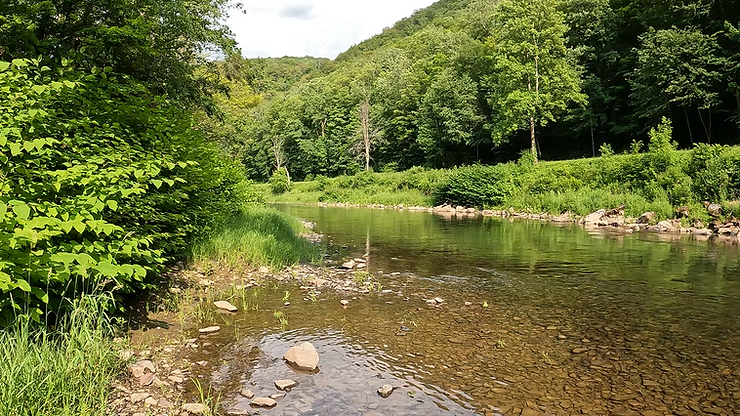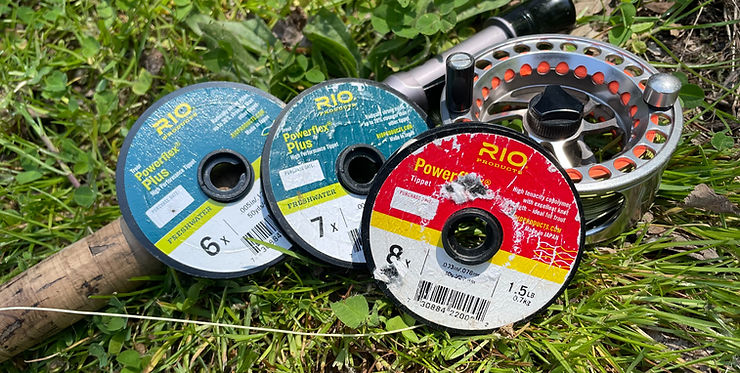Finicky Trout and BWOs: Matching the Evening Hatch on Pine Creek

For the first time ever, I drove down Owasse Road to the Delayed Harvest Artificial Lures Only (DHALO) section of Pine Creek in the PA Grand Canyon and encountered no other vehicles parked along the stream. Moreover, after tugging on my waders and stringing up my rod, I pushed through the foliage to the water’s edge and found not a single footprint left behind in the mud by recent anglers.
“Probably because all the trout are dead,” I thought sarcastically. Just then, a trout swirled only ten feet in front of me. Upstream, another trout took something off the surface. I didn’t realize it then, but things were about to get serious, and I was on the verge of having one of my best outings of the whole season.
It’s been a disheartening few weeks (months?) in this region of the country. Low water and warm temperatures have taken their toll on many fisheries. Drive by most local streams and you’ll likely see more rocks than water. Fortunately, daytime temps have been unseasonably cool, which means water temps have stayed fairly decent. However, it’s hard to get too psyched up about stream fishing when it feels like you’re simply playing in a puddle.
Last week’s rain brought a welcomed change, though, and I decided to head down to the Pine Creek DHALO in the PA Grand Canyon one evening. I hadn’t fished there since mid-April, and I wondered how the trout had fared through the low, warm water. I wasn’t expecting much, so it was a pleasant surprise to find a few fish feeding on the surface. The action wasn’t heavy enough to convince me to try a dry fly, though, so I tied on a couple of nymphs and went to work.
Figuring it Out
Pine Creek in the canyon is fairly big water, but in June – and especially this year with so little rain – it’s a different animal. The heavy currents of spring were gone. The deep pools were gone, too. In fact, the stream was skinny to the point of being unrecognizable from its spring appearance. Despite that, it didn’t take long to hook and land my first trout of the evening, on a size 14 pink-collared Walt’s Worm. The fish fought hard in the cool water, which registered in the mid-60s, according to my thermometer.
The next three trout, in a span of 20 minutes, all took the dropper nymph, also a Walt’s Worm but tied on a size 16 hook with a purple metallic bead and dark hare’s ear body. This fly has become one of my go-to patterns for late-spring/early summer trout. Also, generally speaking, flies that incorporate some sort of purple have worked exceptionally well for me this year. I don’t know if it’s due to the low, clear water or because I’ve used purple flies more than usual, but that color has been very productive for me.
After I got my rocks off on a few fish, I decided to switch to dries to see if I could figure out what the trout were feeding on and actually match the hatch. As far as I could tell, there was no specific hatch happening. Sure, there was a virtual smorgasbord of bugs in the air – a couple Grey Fox here, one green caddis there, and the occasional Light Cahill or big, dopey stonefly thrown in for good measure – but not a lot of one particular species. But something was happening, because the number of rises in the long run in front of me quickly increased in both quantity and frequency.
Admittedly, these are hard situations to figure out. Many of the rises were subtle dimples and swirls. When I see that, I automatically think they’re feeding on small stuff, so I tied on a size 20 Baetis Cripple Emerger, which has worked well for me during these situations. Overall, though, the reception was lukewarm. A couple trout hit the fly with open mouths, not really wanting to eat it, which told me that the pattern was close, but not close enough. I had the same results when I tried a Grey Fox followed by a Light Cahill.
After that, I took a drastic U-turn and tied on a size 10 olive Stimulator. Sometimes, throwing a fly that’s totally different than whatever their feeding on can get trout to hit. In this case, once again, I had three separate trout slash the fly but never commit to eating it. When I set the hook, no fish was on the end of the line. Although it was nice to see the takes, it was hard to feel successful without actually landing a few fish, especially considering that there were now a couple dozen trout rising in front of me.
The ”Aha” Moment
A few weeks ago, I was fishing the East Branch Clarion River with my buddy Doug and had a heck of a day catching trout on the purple beadhead Walt’s Worm. Doug made an observation that stuck with me. He said the fly was probably so effective because the Blue Wing Olives were active. All of a sudden, what I was seeing – and not seeing – on Pine Creek that evening started to make sense.
Blue Wing Olive hatches can be hard to identify, mainly because they’re difficult to see due to their dun-colored wings and olive-brown bodies blending in with their surroundings. They typically occur on overcast days and often when it’s raining, and can range from size 14 on down to teeny tiny depending on the stream and time of year.
I rummaged through my dry fly box and came up with a size 16 Blue Wing Olive. First cast, a trout ate the fly as though he’d been expecting its arrival. Second cast, another trout did the same. I landed around two dozen more trout before finally calling it quits for the evening.
Looking back, I could have probably ended up with a decent number of catches if I’d stuck with the purple beadhead Walt’s Worm. Or I could have slugged it out with a dry fly that was just close enough to make fish slash at it — I know a lot of fly fishers who are perfectly content with the action, even if they only hooked a small percentage. And I think sometimes fishermen give up on precisely matching the hatch and write off the experience as “they were midging” or “they were too spooky to catch.” I’ve heard these lines before, and I’m not ashamed to admit that I’ve uttered those phrases many times in the past.
But there’s a certain satisfaction that comes with taking extra time, being patient, and observing what’s happening around you, and then really dialing in your presentation to figure out exactly how to catch the fish in front of you. Nowadays, that’s as much fun for me as actually catching the trout – almost. The part that always amazes me, though, is that when you finally do figure out exactly what the trout want and how they want it presented, even the most “educated” fish seems relatively easy to catch.
You can watch the video about matching the BWO hatch on Pine Creek in the PA Grand Canyon in the video below. And if the spirit moves you, please like and subscribe.
Tips for Better Fly Presentations
Of course, I still missed a few even after switching to the Blue Wing Olive, which is to be expected when fishing over trout that have been heavily pressured all season. To catch these fish this time of year, your presentation has to be perfect, meaning drag-free drifts and avoid lining them. That can be really hard to do with small dry flies. It doesn’t take much drag to impact the drift, but there are multiple ways to improve your presentation this time of year.
First off, try lengthening your tippet. That evening on Pine Creek, I started out with an 18-inch 6x tippet, and although I landed quite a few, I missed equally as many. I lengthened it to almost three feet and my percentage of hookups increased substantially. At the height of the action, I hooked a trout on practically every drift.
Second, scale down your tippet size. Truth be told, after Memorial Day, the only time I use a tippet larger than 6x is when I’m fishing hoppers. Other than that, 6x is my standard setup this time of year, and if need be, I’ll drop down to 7x, particularly if I’m fishing flies size 20 and smaller. The lighter diameter of the 7x tippet will produce a better presentation with less drag than even 6x tippet. (Click here for more tips about fishing small flies.)

Lengthening and scaling down your tippet size can make a huge difference when fishing flies size 16 and smaller.
Third, rather than fish upstream to rising trout, try fishing down to them. Yes, upstream is the way we’re all taught, but on special regs streams that receive a lot of pressure and on wild brown trout streams, that’s not always the best way to present the fly. These trout are cautious and the line traveling over their heads will turn them off as quickly as drag. Multiple times that evening on Pine, I had trout rising right in front of me that I couldn’t catch by fishing up to them. But when I changed positions and floated it down to them, they took the fly without hesitation.
To fish down to rising trout, false cast as you normally would, but instead of shooting the line on the forward stroke, stop short so that the line piles up on the water directly below or in front of you. This slack will unfold as the fly travels downstream and provide a smooth drift. Also, fish with a shorter line and don’t worry about covering a lot of water. Typically, I start at a point upstream just far enough that I don’t spook a rising trout. And then I work down a few feet at a time, targeting individual fish along the way.
Fourth, don’t be afraid to keep changing patterns until you find what works. Sometimes a pattern is best fished on top, sometimes in the film, and sometimes you just have to keep cycling through the options in your fly box until you find what the trout wants. That evening on Pine Creek was a perfect example of this.
Are You Enjoying What You're Reading?
Stay up to date with the Dark Skies Fly Fishing monthly newsletter for free and receive the latest posts in fly fishing news, tricks, tips, and techniques, stream reports, as well as updates on new flies added to the Online Store and exclusive discounts!
Sign Up Now